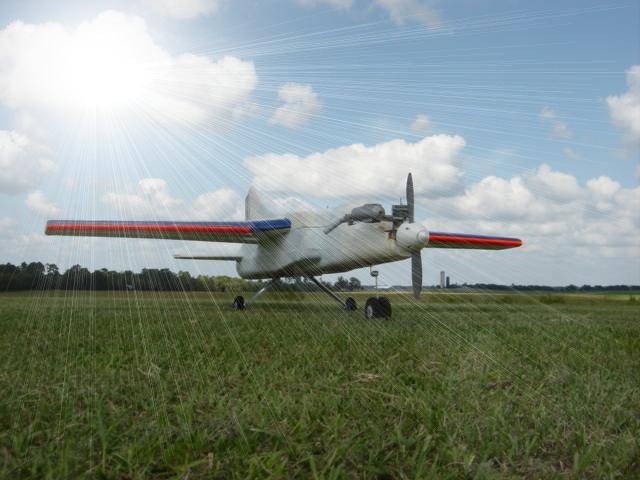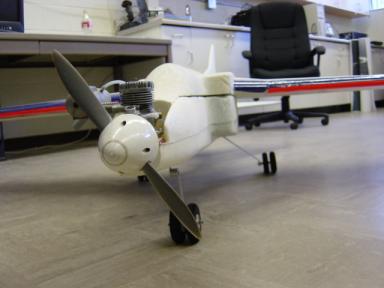
Aspiring to a Higher Degree of
Control
- Adventures in Pursuit of Innovative Wing Surface Actuation -

- Principle Investigator -
Mujahid Abdulrahim -
mujahid@ufl.edu
-Faculty advisors -
Dr. Rick Lind - rick@mae.ufl.edu
Dr. Peter Ijfu pgi@mae.ufl.edu
This project serves as my senior design project and is also an area of interest to NASA Langley Research Center and Ft. Eustis Army Base Aviation Applied Technology Directorate. My primary intent in this effort is to explore the design challenges of developing an airborne flight test platform for innovative wing control. While these numerous challenges are non-trivial, they are very much achievable with a healthy dose of persistence and commissioned expertise. This website will serve as both a summary of progress to date and a roadmap of pending issues.
- Project Summary -
This project will address the initial development of a small, unmanned aerial testbed for control of multiple wing actuators. Specifically, this aircraft will have 16 independently-controlled surfaces in place of the two conventional ailerons. Such a setup will allow us to implement innovative modes of actuation not achievable with conventional surfaces. Ultimately, this number of surfaces might enable the aircraft to be far more maneuverable, more robust, more efficient, and more resilient to changing conditions. The limit is strictly in our ability to understand the aircraft's state and provide the correct command to each servo to achieve the desired result.
In addressing these ambitious goals, my intent is to minimize time spent on redeveloping existing technology. By using making use of existing R/C aircraft, data acquisition systems, sensors, control devices, and other support equipment, my hope is to arrive at a fully-characterized flying testbed at the conclusion of the project.
- Vehicle -

Reflections On Office Life - The Mig-27 awaits action |
The bemused researcher poses with the model |
The flight vehicle for this project is based on a military target drone UAV, donated graciously by the AATD branch of Ft. Eustis Army base. As seen in the above image, it's a 6-foot wingspan styrofoam Mig-27 model. This design, construction, and flying qualities of this aircraft are largely similar to an average R/C aircraft - with the minor exception that R/C models are not typically on the receiving end of a 20mm slug :-)
Given the nature of this project, the actual characteristics of the test airplane are irrelevant. In other words, the goal is not to create an airplane with certain performance specifications, but rather it is to measure our ability to change the performance with the array of wing control surfaces. With that said, however, it's pleasing to note that the Mig-27 is a highly capable aircraft even without modification. In flight, it is both highly stable and fully aerobatic.
The primary specifications of the Mig-27 are listed below:
Wingspan:
70 in
Fuselage length: 78 in
Empty Weight: 8 lbs
Maximum Payload Weight: 5 lbs
Engine: OS 61FX - 12x8 APC propeller
Flight Controls: Aileron-Elevator-Rudder
Radio Control : Futaba 8UAPS PCM 8-Channel computer radio
- Open-Loop Modeling -
"if you don't know where you want to go, then it
doesn't matter which direction you travel"
-Alice in Wonderland
"You need to know where you are to know how to get to
where you want to be"
- Mr. Pickles
Despite the questionable sources of the above quotes, the fact remains that it is imperative to identify the current state before aspiring to impart a change. In other words, we cannot even begin to understand the effectiveness of such control concepts without first understanding the fundamental aircraft characteristics.
The open-loop modeling portion of this project can be likened to the standard flight test characterization process. Here, the goal is to identify the stability derivatives and aerodynamic parameters of the Mig-27. Once a clear definition of the airplane performance metrics has been established, we have essentially created a baseline for comparison. Then, any flight data from the modified airplane system can be quantitatively compared with the standard aero model.
To the open-loop modeling effort are 4 primary components:
1- Vehicle - the very reason we're gathered here today...
2 - Sensors - a suite of devices to measure the physical parameters of interest
3 - Data Acquisition System - some form of recording the output of the sensors
4 - Analysis Tools - software, equations, or some other reference material to help make sense of the data
In one of those curiously convenient happenstance occurrences, all of the components needed for open-loop modeling are readily available. As noted previously with the acquisition of the vehicle, this is one of the many things that makes such a project feasible.
To see preliminary analysis of a flight test maneuver, click on the link below.
Flight analysis of a reverse Cuban-eight maneuver
Adventures in flight photography - a pictorial collage of Mig-27 shots